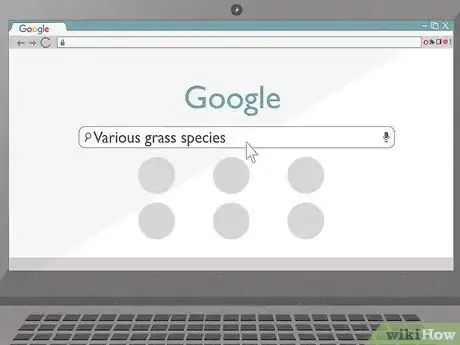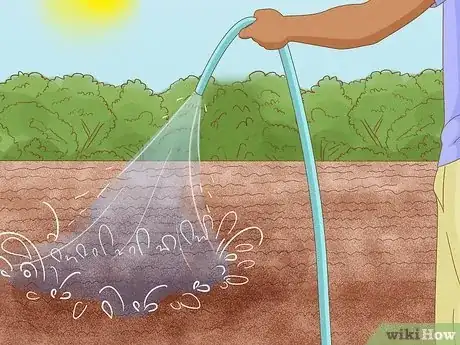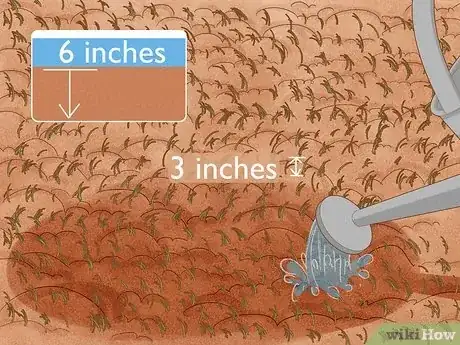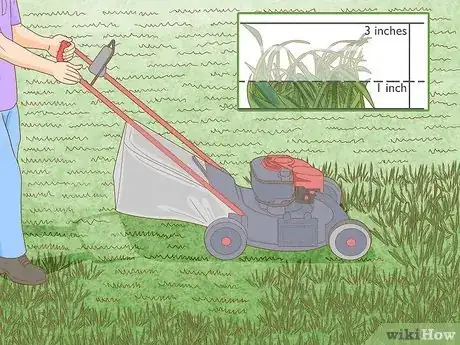This article was co-authored by Grant Wallace. Grant Wallace is a Landscaper and Owner of Grantlanta Lawn in Atlanta, Georgia. With over seven years of experience, he specializes in lawn maintenance and landscape installation. In 2012, he earned his BA from the University of West Georgia. Grant has been profiled in Shoutout Atlanta, Canvas Rebel, and Voyage ATL.
There are 17 references cited in this article, which can be found at the bottom of the page.
If you’re tired of your neighbors giving you the side eye because of your less-than-luscious lawn, it’s time to fix the problem once and for all! Read this article to learn everything you need to know about choosing grass seed, preparing hard soil, and cultivating a vibrant lawn. With a little time and effort, you’ll have gorgeous grass that will make your neighbors green with envy!
Things You Should Know
- Order a soil analysis to identify nutritional deficiencies and pH problems.
- Select a grass species well-suited to your climate and the sunniness of your yard.
- Loosen soil using an aerator or rototiller, then add a compost and fertilizer mixture.
- Keep the top inch (25.4 mm) of soil moist until the grass is 3 inches (76.2 mm) tall.
Steps
Warnings
- Call your utility company before tilling to avoid damaging underground power lines.⧼thumbs_response⧽
- Use caution when operating landscaping equipment. Wear appropriate protective gear, including goggles and close-toed shoes.⧼thumbs_response⧽
References
- ↑ https://treillageonline.com/grass-seed-on-hard-dirt/
- ↑ https://www.nrcs.usda.gov/sites/default/files/2022-10/Soil%20PH.pdf
- ↑ http://npic.orst.edu/pest/countyext.htm#:~:text=Each%20county%20within%20the%20United,%2C%20agriculture%2C%20and%20pest%20control.
- ↑ https://union.ces.ncsu.edu/soil-testing-kits/
- ↑ https://www.canr.msu.edu/resources/establishing_a_new_lawn_using_seed_e2910
- ↑ https://www.homefortheharvest.com/best-grass-seed/
- ↑ https://www.homefortheharvest.com/best-grass-seed/
- ↑ https://www.homefortheharvest.com/how-long-for-grass-seed-to-germinate/
- ↑ https://hgic.clemson.edu/factsheet/zoysiagrass/
- ↑ https://www.inchcalculator.com/grass-seed-calculator/
- ↑ https://www.inchcalculator.com/grass-seed-calculator/
- ↑ https://treillageonline.com/grass-seed-on-hard-dirt/
- ↑ https://www.ehs.wvu.edu/files/d/17934289-297c-4d1c-944a-1291f774a7b2/rototiller-safety.pdf
- ↑ https://www.forbes.com/home-improvement/lawn-care/lawn-aerator-rental/
- ↑ http://www.callbeforeyoudig.org/
- ↑ https://www.forbes.com/home-improvement/lawn-care/lawn-aerator-rental/
- ↑ https://www.ehs.wvu.edu/files/d/17934289-297c-4d1c-944a-1291f774a7b2/rototiller-safety.pdf
- ↑ https://ipm.missouri.edu/MEG/2009/9/Selecting-Good-Top-Soil-for-Lawns-and-Gardens/
- ↑ https://extension.umaine.edu/gardening/manual/selecting-fertilizers-based-soil-test-results/
- ↑ https://treillageonline.com/grass-seed-on-hard-dirt/
- ↑ https://cerch.org/information-for/does-grass-grow-in-compost/
- ↑ https://www.popularmechanics.com/home/lawn-garden/how-to/g237/the-quick-and-easy-guide-to-fertilizing-your-lawn/
- ↑ https://treillageonline.com/grass-seed-on-hard-dirt/
- ↑ https://www.homefortheharvest.com/how-long-for-grass-seed-to-germinate/
- ↑ https://treillageonline.com/grass-seed-on-hard-dirt/
- ↑ https://www.homefortheharvest.com/how-long-for-grass-seed-to-germinate/
- ↑ https://treillageonline.com/grass-seed-on-hard-dirt/
- ↑ https://www.homefortheharvest.com/how-long-for-grass-seed-to-germinate/
- ↑ https://treillageonline.com/grass-seed-on-hard-dirt/
- ↑ https://www.canr.msu.edu/resources/establishing_a_new_lawn_using_seed_e2910
- ↑ https://extension.oregonstate.edu/news/it-best-cut-grass-often-leave-clippings-lawn
- ↑ https://extension.oregonstate.edu/news/it-best-cut-grass-often-leave-clippings-lawn
- ↑ https://www.canr.msu.edu/resources/establishing_a_new_lawn_using_seed_e2910
- ↑ https://treillageonline.com/grass-seed-on-hard-dirt/
- ↑ https://www.popularmechanics.com/home/lawn-garden/how-to/g237/the-quick-and-easy-guide-to-fertilizing-your-lawn/







































































